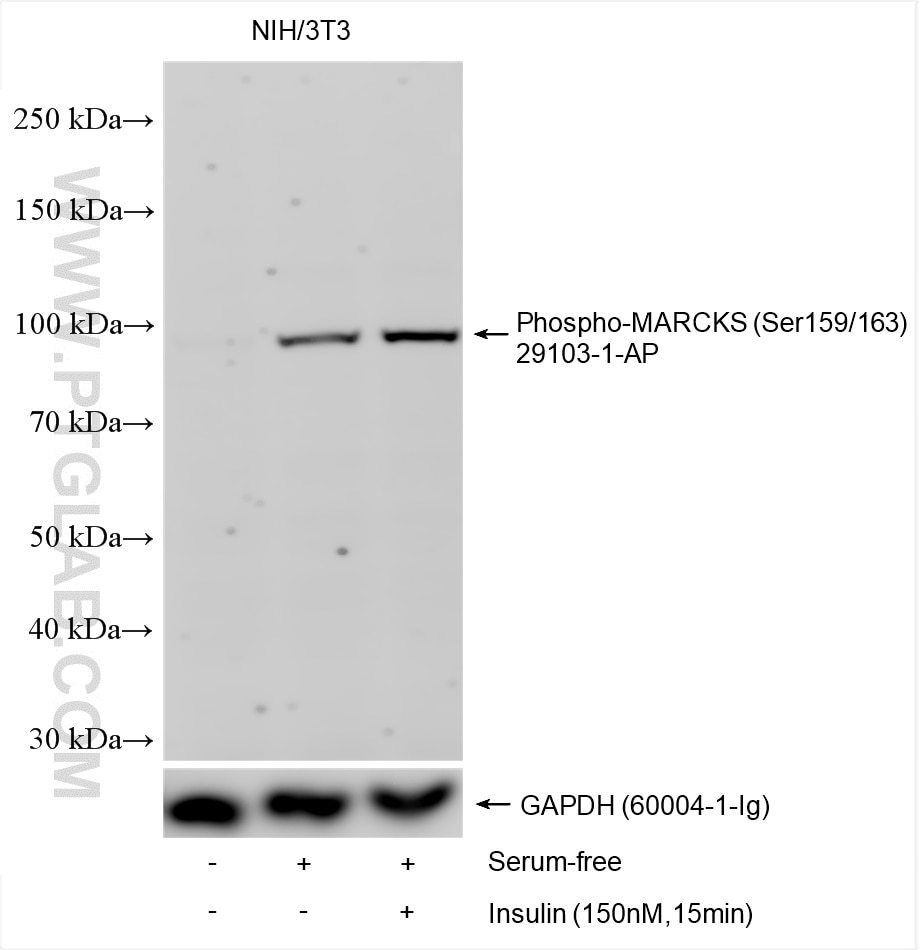Anticorps Polyclonal de lapin anti-Phospho-MARCKS (Ser159/163)
Phospho-MARCKS (Ser159/163) Polyclonal Antibody for WB, ELISA
Hôte / Isotype
Lapin / IgG
Réactivité testée
Humain, souris
Applications
WB, ELISA
Conjugaison
Non conjugué
N° de cat : 29103-1-AP
Synonymes
Galerie de données de validation
Applications testées
| Résultats positifs en WB | Serum-free treated NIH/3T3 cells, |
Dilution recommandée
| Application | Dilution |
|---|---|
| Western Blot (WB) | WB : 1:1000-1:6000 |
| It is recommended that this reagent should be titrated in each testing system to obtain optimal results. | |
| Sample-dependent, check data in validation data gallery | |
Applications publiées
| WB | See 1 publications below |
Informations sur le produit
29103-1-AP cible Phospho-MARCKS (Ser159/163) dans les applications de WB, ELISA et montre une réactivité avec des échantillons Humain, souris
| Réactivité | Humain, souris |
| Réactivité citée | Humain |
| Hôte / Isotype | Lapin / IgG |
| Clonalité | Polyclonal |
| Type | Anticorps |
| Immunogène | Peptide |
| Nom complet | myristoylated alanine-rich protein kinase C substrate |
| Masse moléculaire calculée | 32 kDa |
| Poids moléculaire observé | 80 kDa |
| Numéro d’acquisition GenBank | BC089040 |
| Symbole du gène | MARCKS |
| Identification du gène (NCBI) | 4082 |
| Conjugaison | Non conjugué |
| Forme | Liquide |
| Méthode de purification | Purification par affinité contre l'antigène |
| Tampon de stockage | PBS avec azoture de sodium à 0,02 % et glycérol à 50 % pH 7,3 |
| Conditions de stockage | Stocker à -20°C. Stable pendant un an après l'expédition. L'aliquotage n'est pas nécessaire pour le stockage à -20oC Les 20ul contiennent 0,1% de BSA. |
Informations générales
The Myristoylated Alanine Rich C-Kinase Substrate (MARCKS) is a ubiquitous, highly conserved protein among vertebrates, which is essential for postnatal survival, and has been widely studied for its functions in the brain and nervous system. Being highly expressed in nervous tissue, particularly during early development but persisting in the adult, it plays numerous roles related to brain growth, neuronal migration, neurite outgrowth, neurotransmitter release, and synaptic plasticity. Protein kinase C (PKC) phosphorylates MARCKS, which converts MARCKS from a membrane-bound protein to a cytoplasmic protein. The phosphorylation site of MARCKS protein is called the effector domain (ED). Its structure is highly conserved. It can be combined with cell membrane, PKC, calcium/calmodulin-dependent kineses (CaMK) and F-actin. Studies have shown that increased membrane-bound, non-phosphorylated MARCKS might be conducive to the stabilization of synaptic morphology. Phosphorylated MARCKS protein (P-MARCKS) can regulate the stability of actin network and alter the synaptic structure. (PMID: 30655546, PMID: 30155805)
Protocole
| Product Specific Protocols | |
|---|---|
| WB protocol for Phospho-MARCKS (Ser159/163) antibody 29103-1-AP | Download protocol |
| Standard Protocols | |
|---|---|
| Click here to view our Standard Protocols |
Publications
| Species | Application | Title |
|---|---|---|
World J Gastrointest Oncol LINC01268 promotes epithelial-mesenchymal transition, invasion and metastasis of gastric cancer via the PI3K/Akt signaling pathway and targeting MARCKS |


